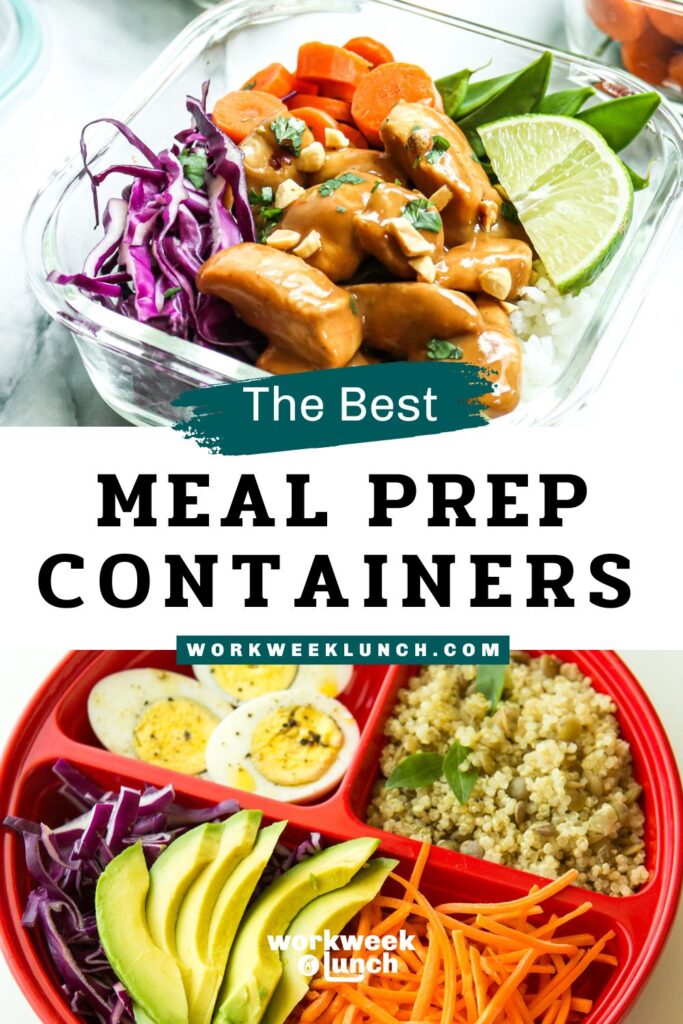Meal prep containers are the foundation of meal prepping. Literally. They help us portion out food so it’s grab-and-go ready, prevent spillage in our favorite lunch bags, and survive many years (ideally) of use and washing.
But with so many materials, brands, and styles available, it can be tough to know which containers are right for you and your lifestyle. Information overload is also a thing; have you ever heard of the expression “analysis paralysis”?
So, we bring you the Workweek Lunch guide to finding the right meal prep containers for you! We’re breaking down the materials (glass vs. plastic vs. metal vs. who knows what else!?!), brands, and all the bells and whistles available. We will give you the pros and cons, both for your lifestyle and the earth, too.
Even if you’ve got a good assortment of containers, you might find this guide useful. Maybe there’s a size or style that you’ve been searching for?
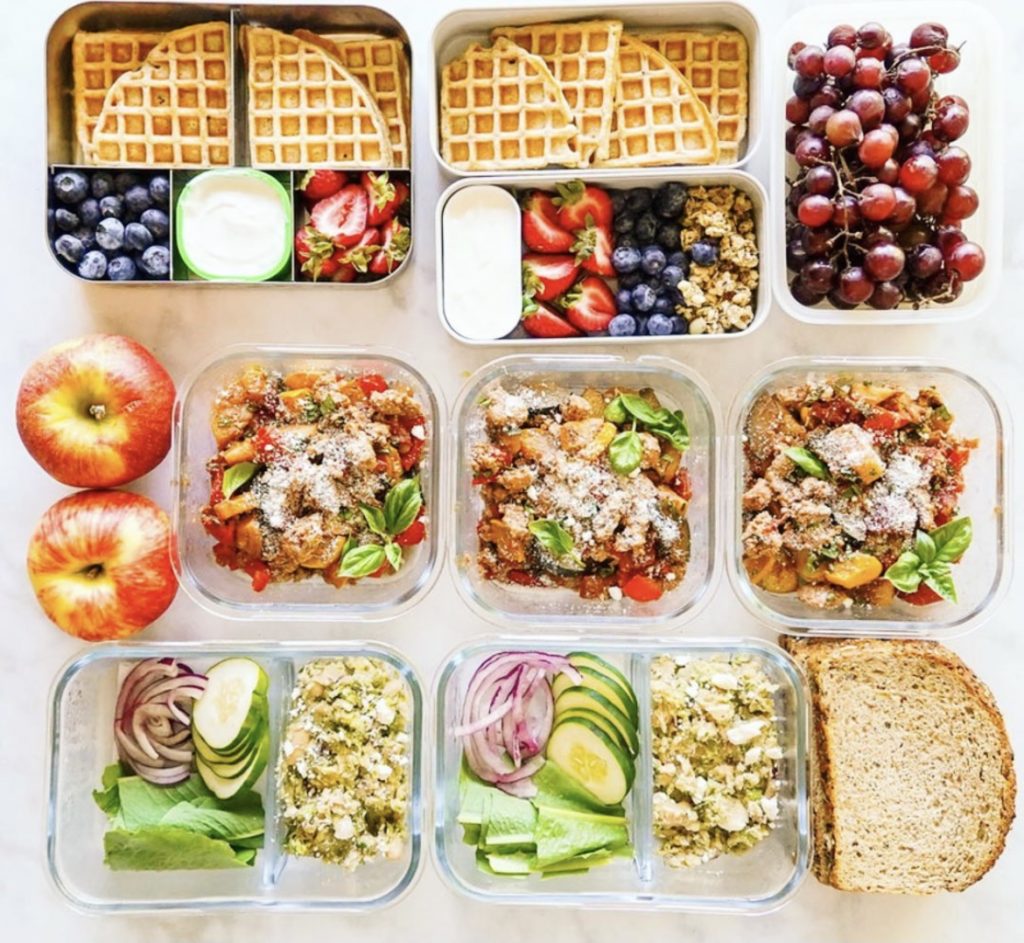
Find the Right Container Sizes
Finding the perfect size meal prep containers for your lifestyle and eating preferences can feel daunting. With sizes ranging from one cup up to seven cups (and beyond), it can be tricky to figure out which size (or sizes) are going to be your perfect meal prep match.
It’s especially confounding because sometimes you might be prepping for individual portions, and other times you might be batch-prepping things like casseroles, and they kinda take up more room. Sometimes freezer size is a limitation to finding the right meal prep container. See, it’s a bit much, isn’t it? (We’ve got you!)
My best tip for beginner meal preppers: buy a few cheap containers in different sizes. You really won’t have a good idea of which size containers will work best for you until you try them out. GoodCook and Glad make sturdy, safe, and inexpensive plastic containers that come in a variety of sizes. Find them in the grocery store or pharmacy by all the foil and saran wrap next time you hit the store. It’s also useful if they can go in the top rack of the dishwasher, but when you’re first starting out that might not be a huge priority. (Or maybe you don’t have a dishwasher!)
Related: Meal Prep for Beginners: 5 Things You Need To Know Before You Start Meal Prepping
You may find that your first few times testing out containers you end up packing way too much or too little food. That’s okay! Figuring out your perfect portions will take a few weeks, but once you get there, you’ll know exactly what container sizes are your perfect fit. And you might find it varies from one type of meal prep to another, and that’s ok, too. Variety is the spice of life, as they say.
I find success with a 29oz (3-cup) size container for most meals. I also really enjoy big salads for lunch, so my container of choice is usually a 7-cup circular container, so there’s room for salad and toppings and room to shake with dressing. Salad takes up a lot of room!
Below: a 7-cup container on the left and a 3-cup container on the right (both from Pyrex).
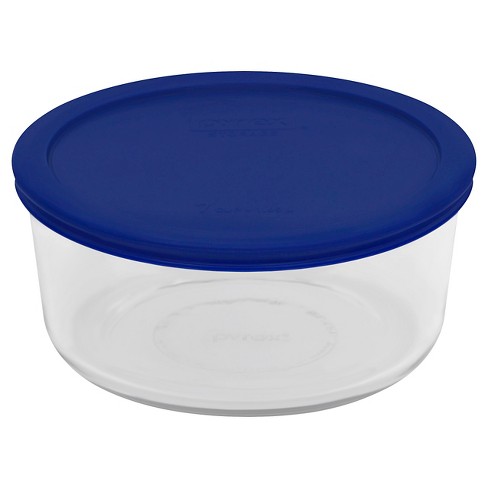

Container Shape Matters, Too
A lesser consideration, but still one worth mentioning: think about how you’ll transport your meals (if you need to). Fitting a circular container in your backpack may not work, but a rectangular one of the same size could work well. Containers come in rectangular, circular, and square sizes of different depths, so consider whether there’s a shape that will work best for transport (or even just storing in your cabinets!).
Meal Prep Container Materials: Pros and Cons
A quick Google search turns up a lot of opinions on “the best” meal prep container material, but selecting the right material is completely up to your own personal preference. There truly is no one “best” material for your containers, so go with what fits your needs, lifestyle, and budget. It’s all relative.
Related: How To Meal Prep For Two
Plastic Meal Prep Containers
Plastic is either the darling or the devil of meal prep containers, depending on which website you visit. But honestly, just like every other material, plastic has its pros and cons, all of which are related to your preferences and lifestyle, and have absolutely nothing to do with food safety because:
Plastic containers are perfectly safe to store, heat, and eat food from (just make sure they’re BPA-free).
Now that that’s out of the way, let’s talk specifics.
Pros of Plastic Containers:
- Lightweight, especially compared to glass containers
- Won’t break as easily
- Dishwasher-safe
- Microwave-safe
- Less expensive than other materials
Cons of Plastic Containers:
- Can stain easily when exposed to dark-colored foods (like tomato sauce) for a few days
- Can hold onto strong flavors (think curries)
- Plastic containers do take a long time to break down in a landfill if you do throw them away unless you buy ones that are recyclable AND your town or city can recycle them.
- If they crack or have deep scratches in them, they’re no longer safe to use
Hot Take: Plastic containers are a great inexpensive option, especially if you need to transport your food regularly and want to minimize extra weight. They may not be your perfect fit if you’re concerned about sustainability, however.
One final word about plastic: They are also not 100 percent shatter-proof. I’ve frozen stock in quart-size plastic containers, only to have the bottom crack if I accidentally drop it or it gets moved around a little too aggressively in the freezer.
Our Favorite Plastic Meal Prep Containers on Amazon: Food Storage Containers 10 pack (30 oz)
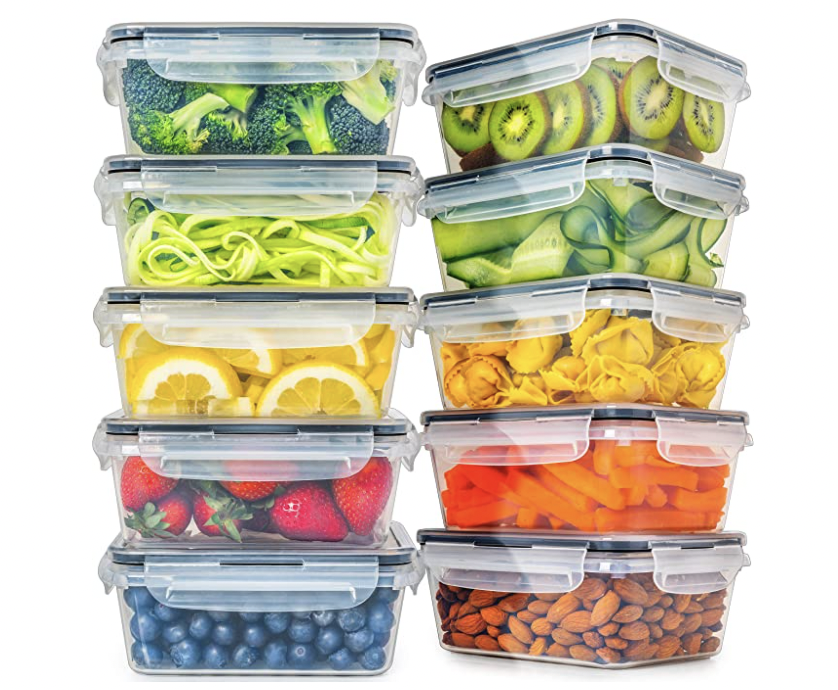
Glass Meal Prep Containers
Glass containers are a great, sturdy option for meal prepping. They come in a variety of sizes and shapes but do tend to cost slightly more than other materials, but you might be ready to make that investment or you might just flat-out prefer glass. Here’s how to determine whether glass meal prep containers are right for you:
Pros of Glass Containers:
- Dishwasher-safe
- Microwave-safe
- Usually oven-safe (making them a great option if you don’t have a microwave!)
- Won’t hold onto strong flavors or stain
- They typically last longer than plastic
- Easier to clean
- Can be recycled and/or repurposed
- Better food protection in the freezer than plastic containers (i.e, better at staving off freezer burn)
Cons of Glass Containers:
- Heavy! They are much heavier than plastic
- Breakable
- More expensive than plastic
Quick Take: Glass containers are the way to go if you’ll need to regularly heat your food in the oven and/or if you’re concerned about sustainability. Glass containers may not be the best choice if you need to carry your meals with you or if you’re on a tight budget.
Glass containers are my personal preference! I work from home (so weight isn’t an issue) and I appreciate the sturdiness of glass. I find that it also tends to work well for all different kinds of foods, whereas with plastic, I’m not as inclined to store a spicy curry in there, or anything with tomato sauce.
Our Favorite Glass Meal Prep Containers on Amazon: Pyrex Set Of Six 29 oz Containers
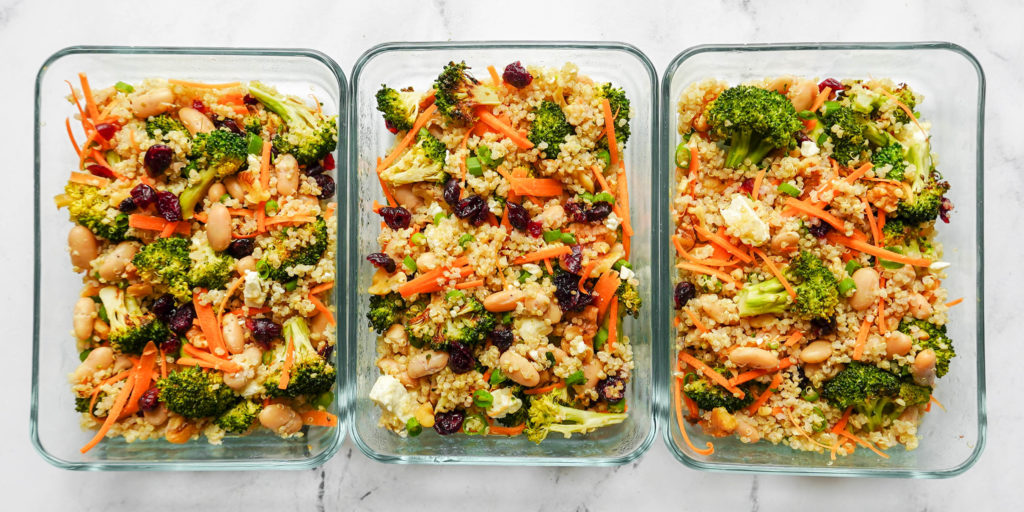
Alternative Materials: Stainless Steel, Silicone, and More!
New materials for meal prep containers hit the market constantly. When considering which containers to buy, think about some of these alternative materials:
Stainless Steel Meal Prep Containers are a great, very lightweight option. The biggest drawback of stainless steel containers is that they can’t be microwaved, so they’re the best no-reheat meals. Look for BPA-free stainless steel meal prep containers, like these (they’re also dishwasher safe!).
Related: Minimalist Kitchen Equipment List: Everything You Need (And What You Don’t)
Silicone Meal Prep Containers are nice because they’re usually collapsible, too. After eating, you can collapse them for easy transport home! They do tend to hold onto strong flavors, so be wary of keeping anything potent in them for too long. These BPA-free silicone meal prep containers are a great option.
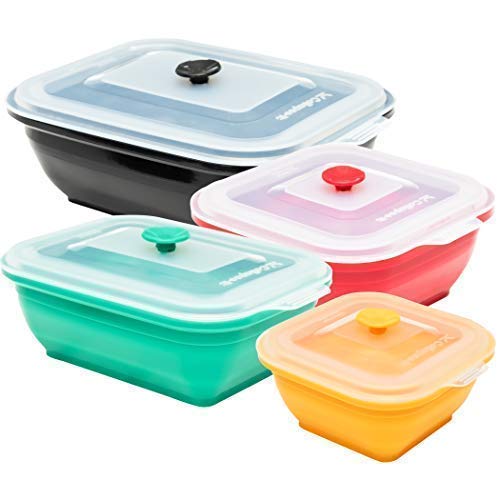
Fancy Containers
If nothing quite suits you, try something a little more souped up (no pun intended, ha ha). If you really wanna get into this, you can experiment with some of these other types of containers. They’ve got a few more these bells-and-whistles:
- Bento-style meal prep containers have compartments to keep foods separate. We love the Lunch Bots brand and use them all the time! They are also fantastic for snack lunches. And if you’re prepping for kids, they’re especially great. These types of containers help kids get better at packing their own lunches.
- “Stacked” containers, like these, are specifically made for keeping salad fresh. Pack your greens and other hearty items (like grains) in the bottom and use the top compartments for dressing, cheese, etc. Then, simply mix at mealtime. So helpful.
- Containers with silverware and condiment compartments, like these, feature Bento Box-style compartments. Some also have silverware that nests in the lid. This can be really helpful if you’re routinely eating in places that are outdoors or otherwise not near a kitchen.
Related: Meal Prep for Kids: Our Best Tips for Busy Parents

Meal Prep Accessories
Once you’ve identified your main meal prep containers, you’ll want to consider some accessories. Reusable storage options like Stasher Bags, Etee Wraps, and mason jars (or rinsed-out glass condiment jars!) are great options for storing or saving leftover foods. I use glass jars to make and store sauces, dressings, and even spice blends for later use.
With all that storage, that’s where labeling comes in. You’ll want freezer tape, to start. It doesn’t pop off easily on frozen items. And make sure you’ve got a Sharpie so you can label and date the contents.
Souper Cubes are also fantastic for storing soups or other freezable meal preps! You can also bake directly into these to minimize cleanup. These are definitely a fan-favorite among the WWL community!
Related: 5 Essential Freezer Meal Prep Tips
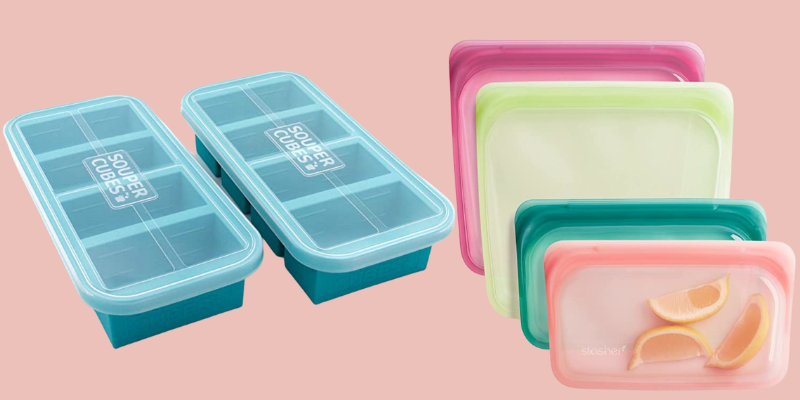
How Many Meal Prep Containers Should I Buy?
To get a general idea initially of how many containers you need, consider how many meals you prep per week and add 2-3 containers for other things (like storing leftover veggies or fruit).
It adds up quickly, right?
For most people (especially if you follow the WWL Meal Prep Program!), 3-4 breakfast containers and 5-6 main meal containers are ideal. Remember, you can always buy more!
If space is at a premium in your fridge or pantry, make sure to grab containers that are stackable.
If you like keeping dressings and sauces separate, you may also want a few tiny containers like these as well. They make it easier to keep those things separate, which can help extend the life of your greens, for example, if you’re mixing in dressing right before you eat.

Traveling With Your Meal Prep Containers
If you need to travel with your containers, two things are helpful. Be sure that they’re leak-proof and have a secure lid; which is usually the kind that snap into place. Meals will stay safe out of the fridge and without an ice pack for 3-4 hours on a cool, mild, or cold day. Otherwise, consider an insulated bag. These are good if it’s a hot day (or your food will need to sit in a warm car). Consider something like the PackIt Freezable Lunch Bag, which features freezable gel sewn directly into the bag lining.
Heading to work? Look for a wide, tote-style bag, like this one, or our favorite, a MinkeeBlue Backpack. (Check out those pockets; perfect for meal prep containers.) When in doubt, don’t forget about lunch boxes! Bring the classic back with this list of 10 lunchboxes that we love!
A good collection of containers is crucial for meal prep! We hope this post helps you make choices that fit your lifestyle and needs. Not sure about what to put inside your meal prep containers?
Check out the WWL Meal Prep Program where we provide new meal-prep friendly recipes every week so you never get bored (or end up with soggy food).
